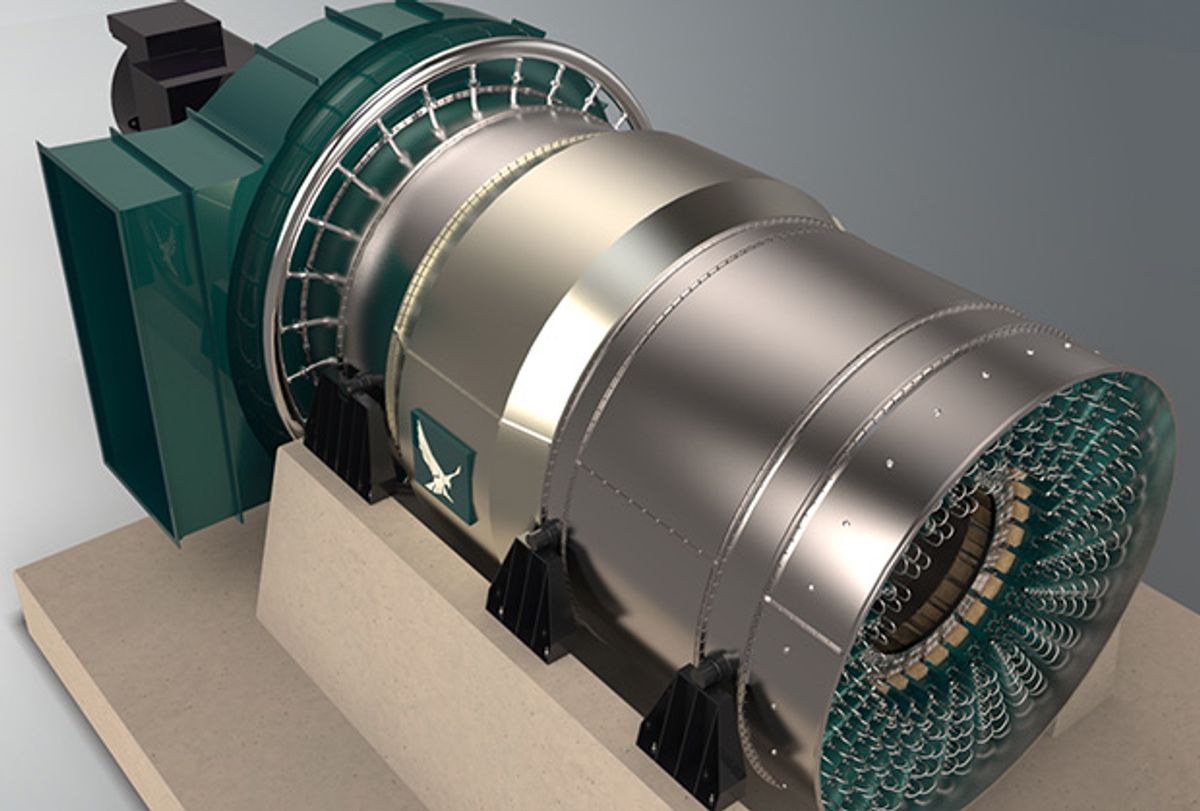The U.S. Department of Energy (DOE) is on the hunt for technologies that can support a smarter electric grid. It is currently devoting millions of dollars, via its SunShot Initiative, to create more efficient photovoltaic systems. But in addition to the solar power that is SunShot's focus, the DOE it is looking to improve conventional electric power generation. Sandia National Laboratories in Albuquerque, New Mexico, along with its new partners, has received $8 million to make advances in supercritical carbon dioxide gas turbines.
Sandia’s take on the Brayton Cycle will utilize the semi-liquid known as supercritical carbon dioxide to power a 6-megawatt gas turbine engine developed by Peregrine Turbine Technologies, LLC. The Sandia researchers say that using supercritical CO2 as the working fluid instead of steam will allow the Brayton Cycle’s thermal-to-electric power efficiency to pass the 40-percent mark. Peregrine’s turbines are significantly smaller than those currently used in power plants. For example, a generator capable of pumping out 20 megawatts takes up only 4 cubic meters of space.
“The goal has been to generate electricity efficiently across the grid,” says David Stapp, CEO of Peregrine. “Distributed power systems have since become more and more attractive.” While it is known that smaller turbines are less efficient than the behemoths that utilities operate, Stapp believes this new technology will counterbalance that and help produce a more stable power grid.
Supercritical fluids can play an important role in developing better electricity generators because of their liquid- and gas-like properties. A supercritical fluid is an optimal working fluid because it has a temperature and pressure above its critical point, meaning that it doesn’t have a definite liquid or gas phase. Consequently, the slightest changes in pressure or temperature cause huge changes in the material’s density.
With any supercritical fluid, the ease of compressibility goes up, explains Stapp, so it becomes something more like water. Because supercritical CO2 also compresses more easily than steam, the amount of work done during the compression phase—normally accounting for 25 percent of the work performed inside the system—is dramatically reduced; the energy saved there greatly contributes to the turbine’s overall efficiency.
“We expand it like a gas, and pressurize it like a liquid,” says James Pasch, principle investigator of the Supercritical Carbon Dioxide Brayton Cycle Research and Development Program. “You can do this with any fluid, but supercritical carbon dioxide matches really well with ambient temperatures.”
Carbon dioxide is optimal for this application because it doesn’t go through a phase change at any point during the cycle. Its critical temperature, 88 degrees Fahrenheit, is very close to ambient temperature, which means the heat emitted by the turbine is the same temperature as the surrounding environment. Supercritical carbon dioxide is also very dense; at its critical point, the fluid is about half the density of water. So, in addition to being easier to compress, less work is required to cycle it back to the heat source for re-expansion.
The Brayton Cycle also offers direct environmental benefits. For one, it’s carbon neutral. The system takes carbon dioxide out of the air and puts it in the recompression cycle loop. Just as important is the fact that the system limits water usage by minimizing discharge, evaporation, and withdraw.
“That’s a big deal for the southwest,” says Gary Rochau, manager of Sandia’s Advanced Nuclear Concepts Department. Sandia’s generator can work in places where water is in limited supply. This puts it on par with the Palo Verde Nuclear Power Generating Station, a nuclear power plant in Arizona that uses recycled waste water as cooling water, saving groundwater and municipal water supplies for other uses.
Once Peregrine Turbines installs the new turbine, Sandia will begin running tests to see if the supercritical CO2–aided cycle can perform up to expectations. By 2019, Sandia plans to maintain a few 10-megawatt turbines for the U.S. Department of Energy; the department is looking to commercialize the technology for bigger reactors by 2035.
“It really comes down to economic concerns and environmental concerns,” says Stapp. “If you can improve the cost of electricity, you can improve the companies and culture that uses it.”
[Correction: An earlier version of this post incorrectly stated that the Palo Verde Nuclear Power Generating Station in Arizona draws water from the surrounding communities’ municipal water supplies. We apologize for the error.]



